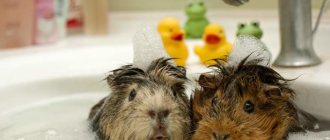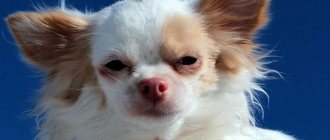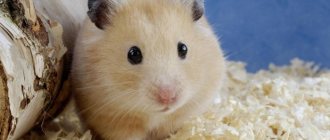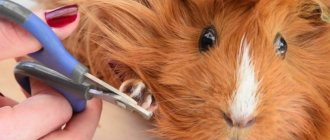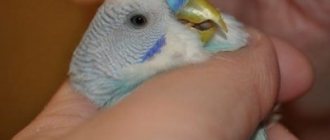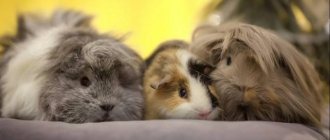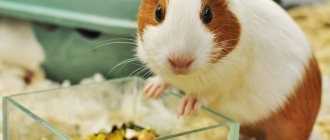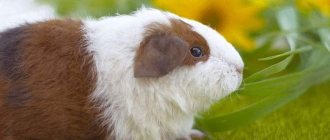Not all rodents can be bathed in water. For example, chinchillas and gerbils only bathe in a bath with fine sand. There is no need to bathe the Djungarians at all; they clean up the mess on their own. Guinea pigs, like hamsters, do not mind water, but they do not always need bathing. Let's figure out when and how to bathe rodents, which everyone calls "sea".
INTERESTING! Initially, pigs in Russian were called “overseas”, but over time the name was shortened to “sea”.
Guinea pigs usually clean their fur on their own.
Is it possible to bathe guinea pigs?
Care and maintenance of rodents includes hygiene procedures. Pigs wash and lick themselves every day, but sometimes this care is not enough. Due to irregular changes of filler, their fur takes on a sloppy appearance and an unpleasant odor.
Excrement and pieces of food stick to it. Therefore, it is okay to bathe your guinea pig from time to time. However, water procedures should not be abused.
In what cases does a pig need to be bathed?
- the animal stinks strongly;
- droppings stuck to the fur and became entangled in it;
- the fur is contaminated with something sticky or a food product, licking which is harmful to the pet’s health;
- with heavy shedding;
- when it is necessary to wash off the ointment or other medicinal composition;
- before the exhibition;
- when crusts appear in the anal area in males (this happens when the fecal pouch becomes inflamed);
- For parasitic infestations, a rodentologist recommends washing your guinea pig.
Do rodents like to swim?
Rodents living in their natural environment do not like to bathe. This surprises many, because the name of the animal is associated with water. Although the ancestors of guinea pigs knew how to swim, dive and even stay underwater for several minutes, their descendants live on land and do not go into the water without reason.
In the wild, rodents often have to cross various streams or bodies of water. However, guinea pigs swim not for pleasure, but to escape from enemies. After heavy rains and floods, animals often find themselves in the water. Despite this, they do not have a special love for water procedures.
How often can you wash your guinea pig?
How many times a year to bathe your pet depends on the length of the coat and the intensity of pollution. Thus, short-haired guinea pigs can be washed less often than long-haired ones - 2 times a year is enough.
Those with thick or curly fur are washed once a month during the warm season. If there is a need to wash a long-haired rodent in the fall or winter, then water procedures are used no more than once every 2 months.
Representatives of the skinny breed should be bathed more often, as an oily coating forms on their skin. It is advisable to wash hairless animals every 30-40 days.
More frequent bathing is undesirable - hard water and detergents irritate the animal’s skin. There is a chance that it will begin to peel and itch.
We make the drinker ourselves
If you don’t have extra funds or want to avoid low-quality hazardous materials, you can try making a drinking bowl yourself. To make a ball sippy cup, you will need:
- pen;
- plastic bottle;
- bearing (bicycle);
- sandpaper;
- silicone based sealant;
- stationery knife.
Step-by-step making of a ball drinker with your own hands:
1. It is necessary to disassemble the handle into its components - you will need its body. 2. Remove the ball from the bearing. 3. Next, you should place the ball in the body from the handle; it usually locks. Make a notch at this point; the unnecessary part needs to be cut off (you can use a hacksaw). 4. Blow into the handle, if there is an air passage, you need to remove excess parts, fixing the ball tightly. 5. Make a hole at the bottom of the plastic container to insert the pen body. 6. To avoid water leakage, apply sealant at the joint. 7. It is necessary to fix the former handle at an angle of 45 °, so the water will flow freely when acting on the ball.
The advantages of a home drinking bowl are that it is made with love for your pet and has a long service life. Disadvantages - not everyone can do this on their own; children will have to resort to the help of adults.
When is swimming prohibited?
Before bathing your guinea pig at home, you should consider whether it will do more harm than good. There are contraindications for water procedures:
- rodent age up to 6 months;
- stress due to a change of residence;
- low temperature or draft in the room;
- pregnancy - while bearing offspring, the female needs complete rest;
- any ailment.
Important! Even if there are no direct contraindications to bathing the pig, but when immersed in water it begins to desperately escape from your hands and squeak, washing should be stopped. It is better to bathe her at another time, when the pet will behave more calmly.
It is not recommended to bathe guinea pigs at an early age. Young animals have weak immunity and are more susceptible to colds. Even a slight change in temperature or a slight draft poses a danger when the animal’s fur is wet.
This is fraught with hypothermia, which will lead to a cold. Veterinarians advise waiting until the pig is 5-6 months old. After reaching this age, the rodent can be washed.
Frequency of procedures
A reasonable question is how many times a month can you bathe a pig. If you have a long-haired pet, it seems that all he does is get dirty, get dusty, become covered in lumps of dirt, and so on.
Regular washing is not considered at all - for a mumps this is an unnatural procedure, so there is no schedule. If in the summer it is very hot, stuffy, and it seems to you that the pig wants to take a bath, then maximum once a month you can briefly give her a light shower. At other times, bathe your pig once every 3 months, not more often.
Frequent washing is dangerous for the animal. Both the water itself and especially the soap solution dry out the animal’s skin. Because of this, figuratively speaking, the pig’s immunity decreases. She becomes susceptible to various diseases.
Even a person can catch a cold after a bath, but a small animal, unaccustomed to its natural habitat, is under direct threat. Therefore, frequently bathing a rodent is strictly prohibited.
There are at least 5 more “don’ts” regarding bathing a guinea pig.
- You cannot bathe the cubs - only adults tolerate bathing procedures relatively calmly. A small guinea pig is threatened by stress from all sides, and it may not survive water stress. And young fur does not need to be washed.
- You should not bathe your pet in the first days at home. Many owners think that the first thing they need to do is bathe the pig so that it is “clean and fluffy” and gets accustomed better. On the contrary, such stress only interferes with the animal’s adaptation. Let him calmly get used to it, everything is new for him, everything is scary, everything is alien.
- Don't bathe your pet in winter. As already mentioned, a cold can be fatal for a rodent. Pigs are extremely sensitive to temperature changes and drafts.
- Do not place pregnant females in the water: bathing is extremely stressful for them and carries serious risks.
- Do not bathe a sick rodent.
Never break these rules - one case of neglect is enough to cause irreparable harm to the animal.
How to bathe a guinea pig correctly
In most cases, you can completely do without swimming in water. Various contaminants can be easily removed from wool with a toothbrush or a wet cloth. If local cleansing does not produce results, you can trim the fur to which food particles or feces are stuck.
The short fur will grow back quickly, so there is no reason to worry.
If no measures help eliminate the problem, you will have to wash your pet.
Preparatory stage
It is important to prepare the animal for a bath in advance to minimize stress. His behavior when in contact with water and his emotional state in the future will depend on this. Experienced breeders recommend first accustoming your guinea pig to the bathroom and the container in which it will bathe.
Gradually, the pet will get used to the unfamiliar environment and feel comfortable.
Many owners start by placing the pig in a dry bathing container and giving him a treat. You can comb the animal in a washing bowl. If you do this every day, the pig will calmly respond to any procedures that are carried out in the bathroom.
At the next stage of training, the pet is placed with its paws in the water, but the body is not yet wetted. If the pig remains calm, then it is ready for water procedures.
Bathing process
First, close all the windows so that there is no draft in the bathroom. For washing you will need a spacious container with high sides - a basin or bowl. You can wash your pet directly in the bath if you don’t have a suitable container at your disposal.
A little water is poured onto the bottom, the temperature of which is +37…+38 degrees. Its level should reach the pig approximately to the middle of the body. A diaper is placed on the bottom so that the rodent can stand confidently on its feet and not slip.
You should prepare in advance everything you will need while swimming:
- detergent;
- ladle;
- wool cleaning brush;
- towel;
- several cotton pads.
During the procedure, the owner of the guinea pig should not leave her side. If he is distracted for a minute to take the necessary item, the animal will get scared and try to get out of the bath. There is a high chance that he will be injured during his escape. Bathing should be done as quickly as possible.
How to properly wash a pig:
- Place the animal in the water and hold it under its front paws with your hand.
- Wet the wool. To do this, you need to water the rodent from a ladle. In this case, you should not lift the container high, otherwise the stream of water will fall softly. You can wet the fur simply with your palm.
- Lather a little shampoo in a cup of water.
- Apply foam to the fur all over the body except the head. It is important to protect your guinea pig's ears and eyes from water and detergent.
- Clean heavily soiled areas with a brush.
- Wipe the muzzle with a damp cotton pad.
- Rinse the shampoo off the body, then pour clean warm water from a ladle over the rodent.
- Wash your pet's genitals thoroughly.
Attention! If crusts have formed in the area of the guinea pig's fecal pocket, before bathing they are lubricated with sunflower or olive oil. Thanks to this procedure, they will soften and can be easily removed with water.
Goals, means and attempts to achieve purity
It's important to remember two things: pigs are helpless compared to you, but they have teeth and claws.
In a calm environment, guinea pigs are very peaceful, but a scared pig can be as dangerous as an angry cat.
Your task is to minimize risks.
Encouragement and training for treats, which works great in such cases for cats or dogs, is almost useless in this case, so you can use ordinary affection and attention.
A few days before washing, get into the habit of taking the pig into the bathroom for 15-20 minutes, preferably at least twice a day, and petting it while holding it on your lap.
A couple of times this can be perfectly combined with combing the fur.
For washing you need to prepare:
- a basin with warm water (the temperature is tested on the skin of the wrist);
- cotton buds;
- towels;
- oil for baby skin;
- hair dryer;
- shampoo for rodents or universal - for dogs, cats and rodents.
When choosing the latter, you should listen to the opinion of the veterinarian.
Bathing
- While stroking the animal's back, carefully place it in a basin of water, the level of which should reach the pig's abdomen.
- You shouldn’t turn on the water: a rearing rodent is funny only for a couple of seconds, and scratches take a long time to heal.
- It is enough to water the pig from a scoop without lifting it much higher than her head.
- A calm conversation and stroking after a week of preparation will quickly calm the animal down.
- When foaming the shampoo, do not make sudden and strong movements: gently massage the animal’s skin, and rinse off the product very carefully - its remnants can harm the pig’s digestive system.
- During washing, it is also necessary to thoroughly clean the anal pocket, located near the animal’s anus, and the foreskin (in males).
This is done using baby oil and cotton swabs:- lightly pressing on the pig's belly in the lower part, carefully and carefully, avoiding damage, clean the contaminated areas;
it is imperative to do this, especially if you do not have the opportunity to clean the cage often (more than 2-3 times a week) to prevent inflammation.
Apply shampoo only when the coat is completely wet.
Be careful not to get water or soap on your guinea pig's head, eyes or ears.
How to properly dry guinea pigs after bathing
Not everyone is able to dry their guinea pig with a hairdryer after bathing. Noise and a strong flow of hot air frighten the animal no less than water. If your pet is not accustomed to this device, it is better not to use it.
In this case, drying is done with a towel. Guinea pig fur gets wet well. To remove residual moisture from the fur, you will need a second towel or flannelette diaper. Next, the animal is placed in the warmest place in the house and kept there until completely dry.
It is still better to dry a long-haired guinea pig with a hairdryer. The device is turned on at the lowest power and temperature and kept at a distance of at least 40 cm from the animal. The air flow is directed along the hair growth. After drying, the pig is combed and treated to its favorite treat.
Features of training
When bathing your pig for the first time, you may experience severe stress, which can negatively affect the general condition of the animal. In order to avoid all unpleasant situations, it is worth accustoming to bathing slowly. In this case, the following recommendations will help:
- About a week before bathing, especially if it is the first time, the pet should be brought into the bathroom for a couple of minutes. In this room you need to speak to him kindly, gently stroke him, comb his hair and play with him;
- Next, you need to place the animal in the bathtub or sink. The piglet must explore these places and get comfortable;
- You can then turn on the water jet or shower, but do not direct the water towards the animal. This procedure will help the rodent get used to the sound of water, and in the subsequent period not be afraid of it.
